
Did you know that an astonishing 300 billion emails are sent every single day? With such an abundance of communication constantly flying through our inboxes, most people receive their fair share of spam, scams and malicious emails trying to gain access to our data.
Phishing attacks are one well-known example of this, and it’s estimated that around 1% of all emails sent are phishing emails – that’s 3 billion phishing emails per day! In case you weren’t up to speed, phishing is when cyber criminals attempt to trick people or businesses into handing over sensitive information like passwords, card details or personal data.
Let’s explore some of the golden rules you can follow to protect your inbox from email phishing scams and stop your data from falling into the wrong hands.
Learn to recognise phishing attempts
One of the first lines of defence against phishing is being able to spot the tell signs of phishing emails. These emails will often try to impersonate well-known businesses, create a sense of urgency, or use generic greetings. Keep an eye out for red flags like unexpected attachments, misspelled URLs, and generic email addresses. Emails from legitimate businesses will usually address you by your full name, so be wary of emails opening with cookie-cutter greetings like “Dear Customer.”
Look before you click
Before clicking on any links or downloading attachments, always take an extra second to be sure of the sender’s identity. Hover your mouse over hyperlinks to preview the destination URL, and be cautious if the link seems unrelated to the email’s content or directs you to a suspicious website. Most companies will never ask for sensitive information via email, so double-check by contacting the company directly through official channels if you have any doubts.
Double down with 2FA
Want to add an extra layer of security without making things too complicated? Two-factor authentication adds an additional layer of protection by requiring a second verification step, usually through a code sent to your phone, meaning that your account usually can’t be accessed even if your password is compromised. Enable 2FA whenever possible to double down on your email security.
Don’t procrastinate on updates
It can often seem tempting to hold off on downloading the latest software updates, especially if you’ve become familiar with your current version. However, regularly updating your email client, operating system, and antivirus software will allow you to patch vulnerabilities and access the latest security features. Set your software to update automatically to ensure you’re always guarded against any emerging threats.
Knowledge is key
Phishing attacks often exploit human vulnerabilities, relying on lapses in concentration and security mistakes to gain access to your data. Educate yourself and your team about the latest phishing techniques and conduct training sessions to keep everyone up to date on best practices.
Email phishing scams are always evolving, but by staying informed, keeping your software updated, and making use of the latest security features, you can avoid becoming a low-hanging fruit and drastically reduce your chances of falling victim to phishing. Happy emailing!
If you’re interested in learning more about how to boost your cyber security and how it can benefit your business, contact us today to speak with one of our experts.